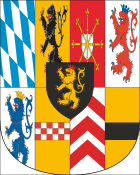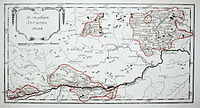Pfalz-Neuburg
|
Territory in the Holy Roman Empire |
|
|---|---|
| Pfalz-Neuburg | |
| coat of arms | |

|
|
| map | |

|
|
| Form of rule | principality |
| Ruler / government | Duke , Count Palatine |
| Today's region / s |
DE-BY
|
| Reichskreis | Bavarian |
| Capitals / residences | Neuburg an der Donau , secondary residence Lauingen |
| Dynasties | 1505–1808 dukes and count palatine of Pfalz-Neuburg |
| Denomination / Religions | Roman Catholic , briefly Protestant |
| Language / n | German |
| surface | 2750 km² |
| Residents | approx. 100,000 (1804) |
| Incorporated into |
Kingdom of Bavaria
|

The Pfalzgrafschaft Pfalz-Neuburg , also known as the Duchy of Pfalz-Neuburg or Young Palatinate , was an independent territory of the Holy Roman Empire that was created in 1505 and actually a principality under constitutional law . Palatinate-Neuburg was genealogically the name of several different lineages of the Palatinate Wittelsbach family .
The royal seat of the principality was Neuburg an der Donau , the secondary residence was Lauingen . It was divided into the regions of Oberland, Pfalz-Sulzbach , Nordgau and Franconia (around Allersberg between Nuremberg and Eichstätt ). The heavily fragmented territory covered 2750 km² and counted around 100,000 inhabitants towards the end of its existence.
history

The Principality of Neuburg was created in 1505 as a result of the Landshut War of Succession through the Cologne arbitration award of King Maximilian I and the Ingolstadt Treaty of 1509. It lasted until 1808. Due to the imperial decision, parts of the legacy of George the Rich with annual income of 24,000 guilders from Bavarian areas, mainly north of the Danube , were created for the two sons of Wittelsbach Count Palatine Ruprecht von der Pfalz , Ottheinrich and Philipp . Since Ottheinrich and Philipp were still minors, their grandfather, Elector Philipp , was appointed as guardian , from 1508 Count Palatine Friedrich II (until 1522). Soon after the end of the reign, Philip entered the imperial service and left the rule to his brother. In 1535, however, he returned and forced a division of the principality. While Ottheinrich received the southern part of the country around Neuburg, Philipp ruled the northern part around Schwandorf , Burglengenfeld and Sulzbach . In 1541, the indebted Philip finally renounced the rule in favor of his brother.
The now sole ruling Ottheinrich converted to Lutheranism the following year . His complex life led in 1544 to the bankruptcy, after which the estates chaired by Hanns Krafft of Vestenberg on Castle Fronberg ( Schwandorf ) took over the government of the country. During the Schmalkaldic War , troops from Emperor Charles V occupied the country, as Ottheinrich was (justified) suspected of supporting the Schmalkaldic League in the war against the Emperor. The outlawed prince went into exile while the country was administered by imperial governors. After the prince uprising in 1552, Ottheinrich was able to return to Neuburg.
After Ottheinrich became Elector of the Palatinate in 1556, he ceded his old principality, the so-called Young Palatinate , to Wolfgang von Pfalz-Zweibrücken in the Heidelberg succession treaty in 1557 . After his death in 1569, Neuburg fell to his eldest son, Philipp Ludwig , who founded the younger line of Pfalz- (Zweibrücken-) Neuburg. Pfalz-Sulzbach was separated first under Philipp Ludwig's brother (until 1604) and under his son (from 1614).
In the Jülich-Klevischen succession dispute in 1609/1614, the Lower Rhine states of Jülich and Berg fell to the Count Palatine of Neuburg, and in 1685 also the Electoral Palatinate . Under Count Palatine Wolfgang Wilhelm Neuburg became Catholic again in 1616/1617. From 1717 to 1718 Charles III resided . Philipp returned to Neuburg for a little more than a year, while the rulers now preferred the residences in Düsseldorf, Heidelberg and Mannheim. With him the main line of the Neuburg Count Palatine died out at the end of 1742, and the Sulzbach branch of the House of Neuburg succeeded him. In 1777 these were also inherited by the Bavarian Wittelsbachers , so that under the Pfalz-Sulzbach line the large Wittelsbach states were united to form Electoral Palatinate-Bavaria .
When the feudal restrictions ceased to exist as a result of Bavaria's sovereignty, King Maximilian I or his first minister, Count Montgelas , abolished the principalities of Neuburg and Sulzbach in 1808. The associated areas were assigned to the nearest district ( administrative district ). For Neuburg, from 1808, this was the Upper Danube District , which since 1819 roughly corresponded to today's Swabian district and was also called that since 1837. The areas around Sulzbach were connected to the Regenkreis in 1810 and to the Upper Palatinate in 1837 .
List of the dukes and count palatine of Pfalz-Neuburg
Older Neuburg Line (1505–1557)
- Ottheinrich and Philipp , 1505–1541
-
1505–1522: Regency for the underage princes
- Elector Philip of the Palatinate , regent 1505–1508
- Count Palatine Friedrich II , regent 1508–1522
- 1522–1523: joint government of the brothers
- 1523–1535: sole government of Ottheinrich
-
1535–1541: Division of the country:
- Ottheinrich rules the southern part of the country (Neuburg)
- Philipp rules the northern part of the country (Schwandorf, Sulzbach )
- Ottheinrich, sole prince from 1541–1557
- 1544–1546 administration by the estates chaired by Hans Krafft von Vestenberg
- 1546–1552 imperial occupation and administration after the Schmalkaldic War
Line Palatine Zweibrücken (1557-1569 / 1808)
- Wolfgang , 1557–1569, because of the division of inheritance among his sons, Zweibrücken, Sulzbach and Neuburg separate again
Younger Neuburg Line (Pfalz-Zweibrücken-Neuburg) (1569–1742)
- Philipp Ludwig , 1569–1614
- Wolfgang Wilhelm , 1614–1653
- Philipp Wilhelm , 1653–1690
- Johann Wilhelm , 1690-1716
- Karl Philipp , 1716–1742
Line Pfalz-Sulzbach (1742-1799)
- Karl Philipp Theodor , 1742–1799
Line Palatine Zweibrücken-Birkenfeld-Bischweiler (1799-1808)
- Maximilian Joseph , 1799–1808, King of Bavaria since 1806
literature
- Michael Cramer-Fürtig: sovereign and estates in the principality of Pfalz-Neuburg. State formation and class organization in the first half of the 16th century , Beck, Munich 1995, ISBN 3-406-10686-2 (series of publications on Bavarian regional history, vol. 100; also dissertation, Regensburg 1992).
- Helmut Eikam: Landstandschaft and landscape commissioner in the Principality of Palatinate-Neuburg. A contribution to the legal forms and institutions of the modern corporate state , Diss., Mainz 1978.
- Stephan Lippold: By the grace of the emperor. 500 years of the Principality of Pfalz-Neuburg , House of Bavarian History, Augsburg 2005, ISBN 3-937974-03-2 .
- Karl Mayr: Pfalz-Neuburg and the Kingdom of Naples in the 17th and 18th centuries , Munich 1939.
- Horst H. Stierhof (Red.): 475 years of the Principality of Pfalz-Neuburg , Wittelsbacher compensation fund , Munich 1980.
- Alfred Thousand Pound: The Manufactory in the Principality of Neuburg. Studies on social and economic history with special consideration of large-scale business development in the age of mercantilism , Nuremberg City Archives, Nuremberg 1975, ISBN 3-87432-034-0 (Nürnberger Werkstücke zur Stadt- und Landesgeschichte, Vol. 16; also diss., Erlangen / Nuremberg 1975).
- Siegrid Westphal : woman and Lutheran denomination. An investigation into the principality of Pfalz-Neuburg 1542–1614 , Lang, Frankfurt am Main 1994, ISBN 3-631-46246-8 .
Web links
- By the grace of the emperor. 500 years of Pfalz-Neuburg
- Historical search for traces - The Young Palatinate in Bavaria
- Pfalz-Neuburg: Historical Maps (House of Bavarian History)
- Markus Nadler, Pfalz-Neuburg, Duchy: Political History, in: Historisches Lexikon Bayerns (July 20, 2012)
- Markus Nadler, Pfalz-Neuburg, Duchy: Territory and Administration, in: Historical Lexicon of Bavaria (September 7, 2012)
- Markus Nadler, State of Palatinate-Neuburg, in: Historical Lexicon of Bavaria (July 9, 2015)
- The Pfalz-Neuburgische Landesaufnahme 1597 / 98-1604. (digitized maps).
Individual evidence
- ↑ Historical search for traces - “The Young Palatinate in Bavaria”. House of Bavarian History , 2005, accessed on June 19, 2016 .